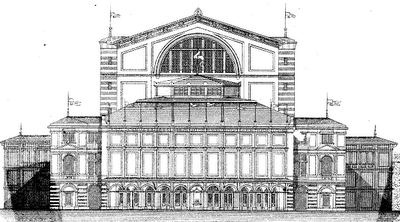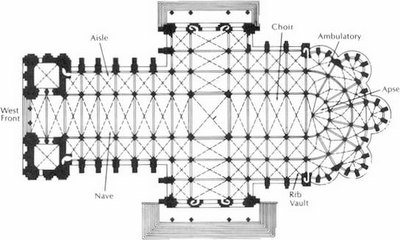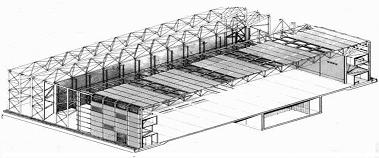Digital technology builds a virtual concert hall

An important 2CD set from an enterprising Seattle record label reminds us that the massive number-crunching power of today's PCs can bring musical benefits beyond the ubiquitous MP3 file download. Acoustics remain a highly fallible science. A number of modern concert halls, including London's Barbican and Royal Festival Halls and New York's Avery Fisher Hall, have all undergone extensive, and expensive, rebuilds in search of the perfect sound, while the computer-less architects of yesterday, who built halls including Amsterdam's Concertgebouw and Bayreuth's Festpielhaus (above), had an infuriating habit of getting it right.
In a very thought provoking project Loft Recordings have leveraged modern computing power to demonstrate how a virtual acoustic can be created. The acoustics of Chartres Cathedral in France were mapped using a tone sweep played through three monitor speakers placed in the cathedral crossing (see diagram below), and recorded through microphones placed eleven meteres away. The difference between the original sweep tone and the recorded sound is the acoustic 'signature' of the cathedral. This signature was then encapsulated in a computer algorithm, this means any recording processed by it takes on the characteristic sound of Chartres Cathedral. The number crunching involved in the process is awesome. The reverberation period in Chartres is slightly more than ten seconds. The processing computer has to take each digital sample of the original recording and apply the algorithm to it to generate 10 seconds worth of results. The sampling rate was 44,100 times per second, per channel. This means that for each second of stereo sound, the computer had to generate 38,896,200,000 numbers!

Commendably, Loft Recordings have not used this new technology as a sales gimmick, but rather as a very useful appendix to a first-class recording of Tournnemire's organ works played by J.Melvin Butler made on the new instrument in the Finney Chapel in Oberlin College, . The organ was constructed by C.B. Fisk, and is modelled on the classic Cavaillé-Coll instruments in Epernay, Caen, Toulouse, Rouen, Lyon, and in Paris, St Sulplice and Sacre Coeur (open this link for a database of all Cavaillé-Coll organs). The first CD in the set includes three substantial extracts from Tournemire's L'Orgue Mystique (for more on this monumental work see the links at the end of the article) coupled with several of his notated improvisations. This CD is recorded 'straight' in the Finney Chapel, and is the raison d'etre for the release. The second CD is presented as a bonus, and is exactly the same recording as the first modified to the Chartres acoustic using the computer algorithm.

So what does it sound like? The first CD is an excellent performance and recording of Tournemire's music played on an exceptionally fine new instrument. The 'Chartres' recording is palpably different, with more space around the sound, and more depth and body created by the signature 'lift' in the bass reverberation of the cathedral. I cannot say that the sound is better, or that it is the accurate sound of Chartres Cathedral, but there is no claim that this is the authentic sound of Chartres. The acoustic mapping was carried out at the crossing of the cathedral, and this is not where the organ would be located. Additionally the original recording included the Oberlin acoustic, and this was also 'enhanced' by the reprocessing.
 But Loft Recordings did not release this fascinating 2CD set (LRCD1063-64) to prove they could use a computer to recreate any acoustic. They set out to make a world-class recording of Tournemire in the Finney Chapel complete with excellent documentation. They added as a bonus a thoughtfully presented illustration of the creative possibilities that are being opened up by new technology, and the 2CDs sell for the price of one. Tournemire in Oberlin is a triumph in its combination of artistic excellence and creative experimentation.
But Loft Recordings did not release this fascinating 2CD set (LRCD1063-64) to prove they could use a computer to recreate any acoustic. They set out to make a world-class recording of Tournemire in the Finney Chapel complete with excellent documentation. They added as a bonus a thoughtfully presented illustration of the creative possibilities that are being opened up by new technology, and the 2CDs sell for the price of one. Tournemire in Oberlin is a triumph in its combination of artistic excellence and creative experimentation.* On An Overgrown Path has recently visited other fine organs in St Peter Mancroft, Norwich, St-Louis-en-l'Ile, Paris, the Kaiser Wilhelm Memorial Church, Berlin, the recently restored Frauenkirche in Dresden, St Thomas', Leipzig and Norwich Cathedral.
* The Gothic Catalogue has a wonderful catalogue of organ, choral and early music recordings from Loft Recordings and Gothic records, all made with passion and flair. Do visit their web site and explore the riches.
Image credits: Bayreuth Festpielhaus - Wikipedia, Chartres Cathedral - History.com, Sainsbury Centre, UEA - Greatbuildings.com. Any copyrighted material on these pages is includedin "fair use", for the purpose of study, review or critical analysis only, and will be removed at the request of copyright owner(s). Report broken links, missing images and other errors to - overgrownpath at hotmail dot co dot uk
If you enjoyed this post take An Overgrown Path to 'L'Orgue Mystique' - the music and 'L'Orgue Mystique' - the images.









Comments
This isn't really anything that new, though perhaps it's new to the "classical" world, where things like digital effects and such aren't too commonplace. It'll sound like something new and exciting to those who've never been behind the boards of a recording studio - even a home makeshift one. Admittedly, that's most of the world - but to those of us who have, this is kind of a "Huh? So?"
I guess to someone who's familiar with studio effects, this news is a bit like hearing that a 2CD set is being released - one disc played normal, the second through a distortion pedal or a spring reverb tank.
In studio production they call it "impulse modeling" and it's been around for awhile - the first IM program I played around with was in, like, '98 or '99 or so. I've got a few concrete pieces that make extensive use of them (shameless plug: various parts of my piece "Sanctuary" involved running material through a series of different impulses taken at the Todaiji Temple in Kyoto...)
One of the fun things about the technology is that you can use the same setup to make "impulses" of not just rooms, but vintage effects pedals, amplifiers, and other studio gear. A plate reverb unit costs thousands of dollars - but you can get multiple impulses of them online for free by poking around.
On my system I've got probably close to 200 impulses from churches, temples, empty silos, caverns, bathtubs, swimming pools (empty and underwater) and all sorts of funny-sounding places around the world - some I've taken myself, some came from others. People trade them online. There are programs from which you can create virtual impulses by designing a room in a CAD-like environment, telling the computer what the walls are made of, placing the source speaker and mics in your virtual room and voila. Some of these programs even use impulses taken from specific amplifiers and microphones, so you can not only hear what your guitar would sound like in in some "impossible" Escher-inspired room, but what it would sound like in that room, played through a '65 Fender Champ turned up to 8, and recorded with a vintage Neumann U87. Impulse upon impulse upon impulse.
Anyway, the only reason I can see for this CD release is the gimmick. A gimmick the producers are pretty sure most listeners won't know has been around for a long time.
The front of the CD sleeve makes no mention at all of the second CD, and the rear only carries one small paragraph about it. The 'virtual acoustics' CD is presented as a scholarly appendix to the 'vanilla' recording made in Finney Chapel, Oberlin College.
Any undue emphasis on the 'virtual acoustics' CD is mine, and mine only. I took an editorial decision that it was a worthwhile project that deserved highlighting. The highlighting is mine, not Loft Recording's.
The purpose of the second CD was to raise questions about technology and the appropriateness of its use. This is a case where the organ is about as authentic as one can find in the US, but where the acoustics are more like those of an English "Town Hall". The music was written and performed at Ste Clotilde in Paris, a neo-Gothic church with reverberant acoustics. The question is whether the music is better served by the drier acoustics that the organ was recorded in, or the wetter acoustics of a real French cathedral.
Some of the beneficial musical effects of the Chartres cathedral include:
1. Rolling off of the treble, which gives the organ a tonal balance more like the original Cavaille-Coll organs.
2. Increased strength in the bass, most notable in the pedal reeds, which "roar" and "thunder" more, and "buzz" less.
3. Increased cresecendos and decrescendos, due to the buildup and die down of the reverberation. This is a biggie...
4. Wider variety of touches are possible (you can play with shorter notes, and the room puts it together).
As you might surmise by this post, I am not entirely convinced this is a good thing to do for a classical recording---but I am not convinced otherwsie either! In the CD booklet, I wrote an essay on the philosphical aspects of these choices.
Guthrie - I agree with your statement about classical music CDs in general, but that is not what THIS CD is about...
Roger Sherman, Executive Producer